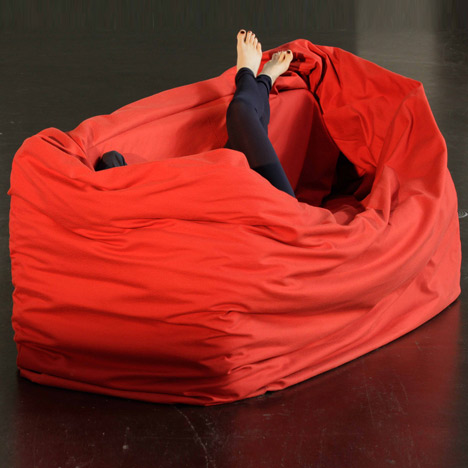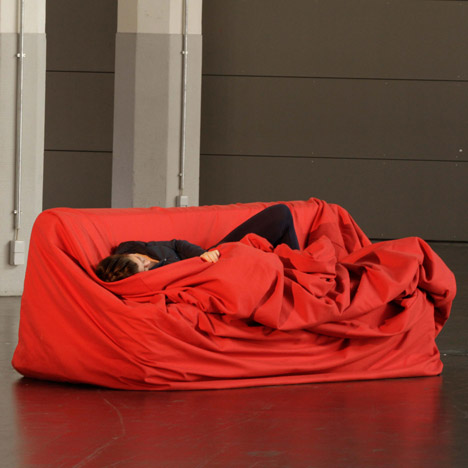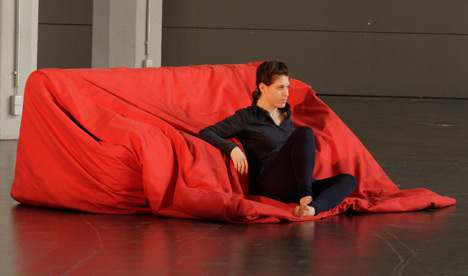 This little folding chair was created by the Finish born and Paris based designer Elisa Honkanen, who proved once again that even inexpensive, utilitarian and temporary things can add delight to our lives. Hasta chair consists of two components – folding tripod and a cotton cover, which resembles kids ‘tell the fortune’ paper game. The beauty of the piece comes from its lightness and naive, even childlike simplicity. But in fact, to achieve the effect, the designer had to experiment a lot with textures and proportions. The piece is currently on show at the Making Of exhibition in Paris.
This little folding chair was created by the Finish born and Paris based designer Elisa Honkanen, who proved once again that even inexpensive, utilitarian and temporary things can add delight to our lives. Hasta chair consists of two components – folding tripod and a cotton cover, which resembles kids ‘tell the fortune’ paper game. The beauty of the piece comes from its lightness and naive, even childlike simplicity. But in fact, to achieve the effect, the designer had to experiment a lot with textures and proportions. The piece is currently on show at the Making Of exhibition in Paris.
This is the second decade of the 21st century, and even though flying cars are sill in the wish-list, some cool things are already out. This lamp for example. What can be more futuristic than drawing out light with your hands? Having been shown at Imm Cologne last week, Rima desk lamp by Dreipuls became a huge hit. Its innovative mechanism contains a series of LED lights, that are controlled by sliding rings along the metal rail. The rings are detected by the optical sensors, and the light emerges. The item had won the prestigious red dot award in 2010.
More news from the Cologne 2011. This unusual piece earned its creator Hanna Emelie Ernsting the second place in this year’s [D3] Talents Competition. Moody couch got its name for its ability to take and retain many shapes. The transformation is achieved thanks to the extended textile cover, which can be draped around the base in many different ways. A high quality cotton upholstery is reinforced by wadding, making the material more luxurious and also able to hold the desired form. Thus, the object can respond to changes in environment and user’s emotional state. The designer calls this concept – ‘form follows moods.’ By detaching cover from the base and giving it freedom, Ernsting created a piece of furniture that is as flexible as fabric. A couch that can wrap around you after a long day – who would not like that…
Source: Dezeen
Shelving is as unavoidable as human need for collecting things. Ordinary shelving, however, is possible to avoid. Consider this piece from Opulent Items and see for yourself. Justly called Contemporary Flexi Shelving, this modular collection can fit any space. The units are sold separately and can be compiled into various configurations. The choice of two sizes allows for an exciting visual variety. Each circle comes with a level base, that stabilizes the items displayed. The piece can be used as a shelving unit, a room divider, or both.
It is that time of year again, when the Imm Cologne (one of the biggest furniture fairs in the world) is in full swing. It started three days ago and will end this weekend; and some sneak peeks have already began to emerge. Here is one jewel I could not let go unnoticed – the Rewrite desk, created by GamFratesi design group for Ligne Roset. The concept of this piece goes beyond aesthetics and ergonomics. The desk is build around the phycological aspect of the writing process. A wooden table is surrounded by a soundproof and light resistant ball, made out of walnut and Kvadrat Divina wool. The user feels secure in this work bubble, even if the room is full of people. A lacquered metal box is attached beneath the desk to hide electrical cables and transformers. The shape is both traditional and surprising. And because it is so secluded in its own space, the desk can be located anywhere in the room without interfering with the overall design scheme. Rewrite has already been displayed as a prototype at the Danish Museum of Art and Design in Copenhagen.
And now for something completely different. A wooden stool made out of a series of triangles, generated by a computer algorithm. This innovative piece, created by Riccardo Bovo, only exists in a form of a prototype. But with its enormous geek appeal, it will most likely go far. Each One Hundred Triangles stool is unique; it uses a random set of triangle pieces, that are laser-cut from wood and joined together with cable ties. The result provides for a lightweight, flexible and fun sitting.
This elegant lightweight piece designed by Léonard Kadid, who gave us a notion of a lamp we need to co-create. Yes, you read me correctly. The lamp does not exist without our input, for it has no base. We are invited to provide our own base in a form of a book. Which is fun as well as pragmatic, because this concept eliminates unnecessary manufacturing costs. Made out of a single piece of plywood bent in two places, Bookmark Lamp is as minimalistic as can be. And since the choice of a book is up to us – interactive too.
If you grew up on this planet during the last two decades of the twentieth century – you were at some point addicted to tetris. So were most of the contemporary designers. Which is why there are so many reenactments of the game – tetris sofas, tetris shelves, tetris rugs… What we see here is the Tetris mirror – a beautiful addition to the tetris family, created by Julia Dozsa for Fiam. This set of modular mirrors can be arranged into various configurations, from slik and classic ones to extremely elaborate. Each angular segment is fitted with the mount, so it can be attached to the wall individually. The Tetris mirror is versatile, playful, it adds light and depth to small spaces. And this is what we, shoebox dwellers want to hear.
It is incredibly pleasing that the American turf can produce its own Jacobsens, Wagners and Kjaerholms. Meet Ryan Diener, a Cincinnati based industrial designer, whose works are inspired by the masterpieces of Scandinavian school. His latest creation – DK Stool – contains all attributes typical for the Danish design tradition. The piece is beautifully crafted, minimalistically shaped and made out of local materials. But the best feature of the DK Stool is that the top of it bends to accomodate the person’s weight, while the legs turn outwards for a better support. No mechanisms, no additional parts; all done by the physics of the form. Clever, simple and elegant… Can your stacking stool do that?
These unusual bookshelves belong to an emerging French designer Adrien De Melo, who very deservingly called her creation Upside Down. Weightless, modular, transparent, suspended from the ceiling, these pieces truly give a new dimension to the idea of book storage. Each shelve consists of five simple components: translucent inflatable cushions, stainless frameworks, lifting straps, maintenance pins and fixing accessories. The units can be organized into different configurations. The Upside Down bookshelves are currently on display at Galerie BSL in Paris.
Update: Designer clarified that the shelves were ordered as a special command from Louis Vuitton Malletier to equip their cultural space, 7th floor of the Champs-Elysées building. The Upside Down shelving is exhibited at the Pavillon des Arts et du Design in Paris until April, 3rd. And if you are lucky enough to be in Milan for the Salone del Mobile’11 – do check out SPAZIO ROSSANA ORLANDI exposition. These shelves will be there!



































